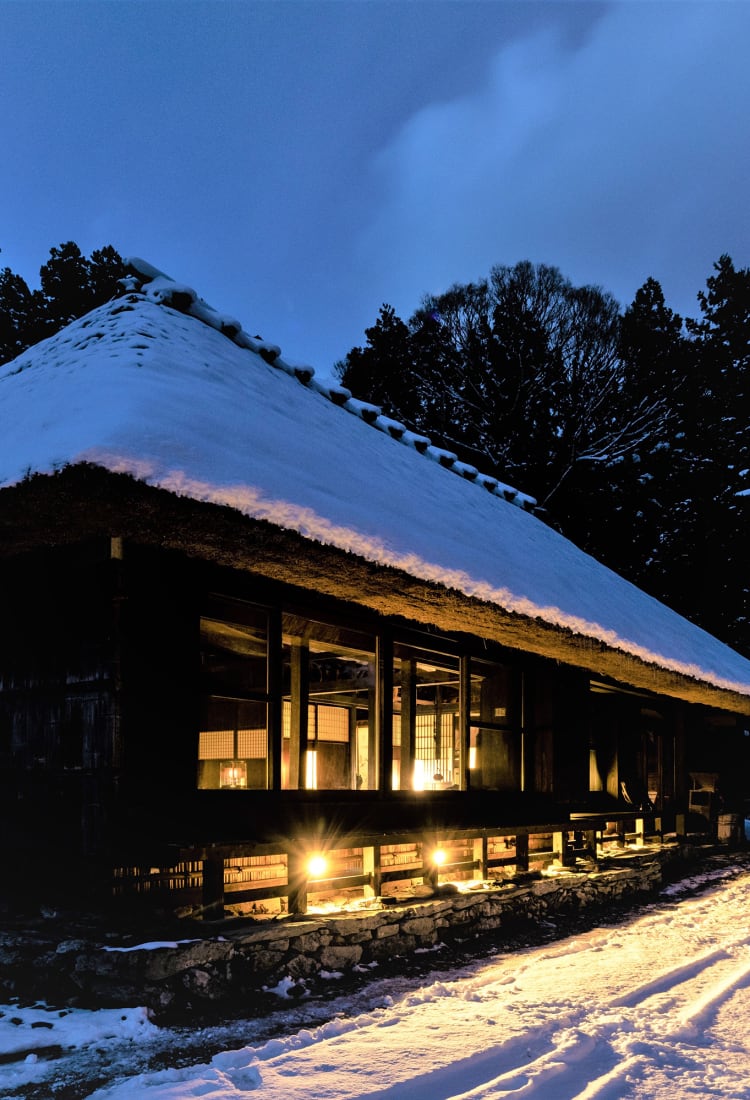
2021.02 Experience Rural Life in a Restored Farmhouse, in Tokushima’s Iya Valley
Experience a 300-year-old lifestyle with some modern comforts
In the 1970s, Alex Kerr, a researcher in East Asian culture and art, was captivated by the area and began renovating old homes. Though the region was experiencing a decline in population when he first visited, the efforts to encourage sustainable tourism have seen the villages in Iya gaining popularity as places where visitors can stay in traditional homes and experience life in a rural community, far from the stresses of the big city.
There are several restored houses in Iya where visitors can stay. The original is “Chiiori”, a villa that Alex developed, creating the foundation for this ecotourism
Getting to Iya is an adventure-in-itself. Many visitors fly from Tokyo to Kochi Ryoma Airport, which is closer than Tokushima Awaodori Airport. From Kochi, it takes about two hours by train to Oboke Station in Tokushima. The station is right next to the magnificent Yoshino River, one of the leading clear streams in Japan, which runs through the Iya Valley.

The view from Oboke Station.
From the station, visitors can take a bus or a taxi to Chiiori. In winter, the Shikoku Mountains and the surrounding forests are covered in snow. It takes about 50 minutes to reach the home, on narrow roads.
Guests who stay at Chiiori will find this traditional Japanese house with a thatched roof has some surprising modern secrets. Entry to the home is by a touch panel lock set in the door. Stays are limited to one group of guests per day and there is no permanent staff on site. The closest house is over 100 meters (330 ft) away, so social distancing is a natural part of staying at Chiiori. English-speaking staff are on call to explain everything in the house.

Mid-winter in Iya is extremely cold, so visitors should wear warm, protective clothing.
Visitors are asked to check their temperatures and disinfect their hands when they arrive. In colder months, guests can buy charcoal for the sunken hearth at check-in. The staff will deliver the charcoal to the house.
Opening the sliding shoji doors reveals an impressive space. The 300-year-old wooden floors and jet-black thick beams and girders give the space a stately atmosphere. Without the typical ornamentations of old Japanese homes, the space is evocative of life as we imagine it might have been in the old days.

There are two living rooms with sunken hearths. Without partitions, the space feels vast.
Above the living space, the open structure of the roof creates ample space, reminiscent of a Gothic cathedral.
Alex Kerr, who developed Chiiori, says that more than anything, he wants guests to feel the power of the house.

The pillars and beams supporting the roof date back to the original construction, 300 years ago.
Looking around the sparse room, there are no furnishings or interior items found in typical hotels such as sofas, tables, beds, or fluorescent lights. The decorations include seasonal flowers and a millstone used to make soba (buckwheat) noodles. These simple items remind guests of the heritage of this traditional farmhouse. While many of the features of a traditional Japanese home such as wooden floors, sliding screens and exposed beams remain, the house was renovated with a focus on modern conveniences such as toilets and baths, so that international guests can stay in comfort.
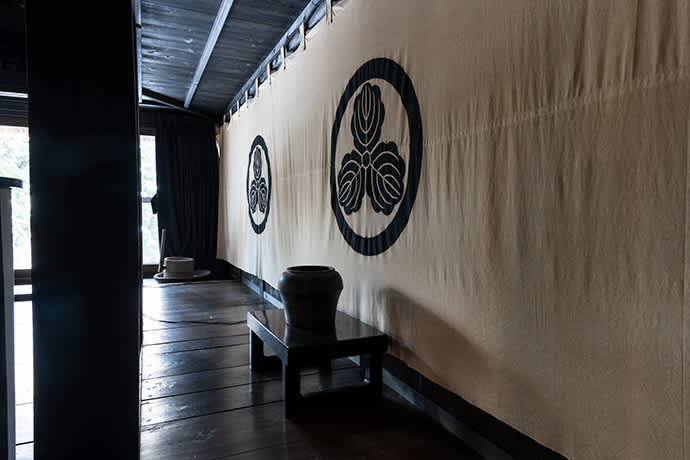
A curtain with a design depicting oak leaves, one of ten widely used family crests in Japan.

The casually placed seasonal decorations blend naturally with the space. (left) Alex wrote the “Chiiori” calligraphy on the sliding shoji door, himself. (right)
Guests are advised to bring their own food to the house, as there are no shops in the vicinity. As the sun begins to set, it’s time to make dinner, using local specialties and ingredients which can be bought at the market in front of Oboke Station.
The kitchen is stocked with equipment, including a refrigerator, IH stove, microwave oven, rice cooker, cooking utensils and tableware. Basic seasonings are also supplied.

The modern kitchen and large dining table blend seamlessly with the traditional look of the house.
One of the pleasures of staying at Chiiori is cooking with local ingredients, such as chicken and vegetable hot pot seasoned with locally-made miso paste. Other specialties of the Iya area include iwadofu (stone tofu), which is quite hard, and sometimes called “garden meat,” Iya konnyaku (konjac), which has a springy texture and is often eaten seasoned with vinegar and miso paste. Grilled freshwater fish is another must-try. The dishes are simple, allowing the flavor of the ingredients really comes through. Cooking with fresh local ingredients adds to the pleasure of eating.

The hot pot (nabe), is a staple of Japanese home cooking in winter, as simple as chopping the preferred ingredients and simmering them together in a soup made with dashi stock and miso paste.
Sitting around the table, cooking, eating and talking together and warming up by the charcoal fire, guests can forget the time and become absorbed in the simple pleasures of traditional Japanese living. Cell phones are soon forgotten as guests rediscover real conversations and the sounds of the countryside.

At night, the light of paper-covered lanterns and the glow of the sunken hearth cast a romantic mood. The sunken hearth cannot be used for cooking.
In addition to cooking for themselves, guests of Chiiori can also enjoy a catered meal by prior reservation. The menu changes daily and is mainly comprised of local specialties. Typical dishes include hirarayaki hot pot cooked on a hot stone, with the ingredients contained by a thick ring of miso paste. Other foods include iwadofu, Iya konnyaku, soba porridge with buckwheat berries and vegetables simmered in dashi soup stock, and a rich boar hot pot in winter.
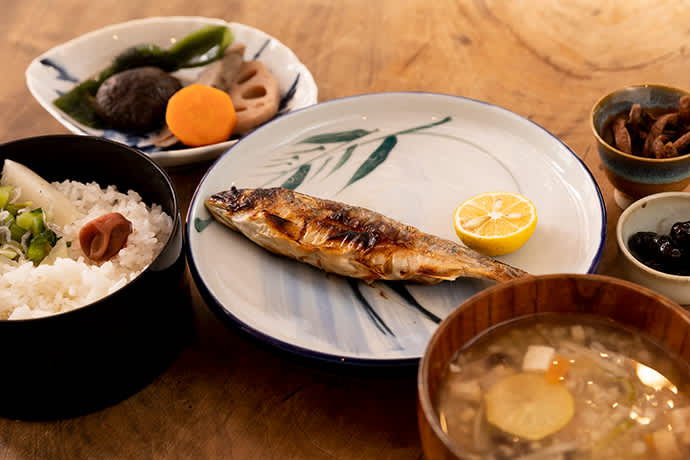
Catered meals let guests experience local dishes with simple flavors.
Alex recommends staying at Chiiori at least two nights, with four or more people. “On the first day, enjoy a catered meal. On the second day, go shopping for ingredients with everyone and make the meal a party while drinking wine or Japanese sake. You can just cook something simple.”
After warming by the fire, it is refreshing to go outside and breathe in the mountain air. There is no sound except the occasional sound of snow falling from the roof. Looking up at the quiet night sky, there are an infinite number of brightly twinkling stars. It’s a spectacular view that can’t be seen in the big city. There is nothing more romantic than sitting together and looking up at the stars, with just the soft light from the paper-covered lanterns set outside.

The stars are bright, away from the city lights. In warm weather, guests can borrow a BBQ set and enjoy cooking outdoors.
After dinner and star gazing, a hot bath is the ideal way to warm up and relax. Unlike the traditional, jet-black living room, the sophisticated cypress bath incorporates lighter colors and modern Japanese design. The refreshing, distinctive fragrance of the cypress wood fills the bath, creating a deep sense of relaxation in both body and spirit. After a warm soak, sleep comes easily.
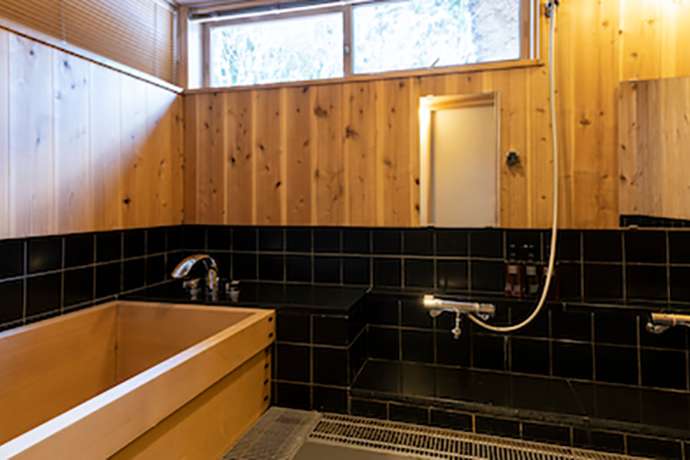
In addition to the bathroom with a cypress tub, there is a shower room.
Visitors tend to wake naturally around sunrise. After a simple breakfast of last night’s leftovers, it’s time to greet a new day. In deep winter, icicles hang from the thatched roof. Snow falls from late December until February in this region, but there are only a few days of heavy snowfall. One of the joys of traveling off the beaten track, is really experiencing the seasons.
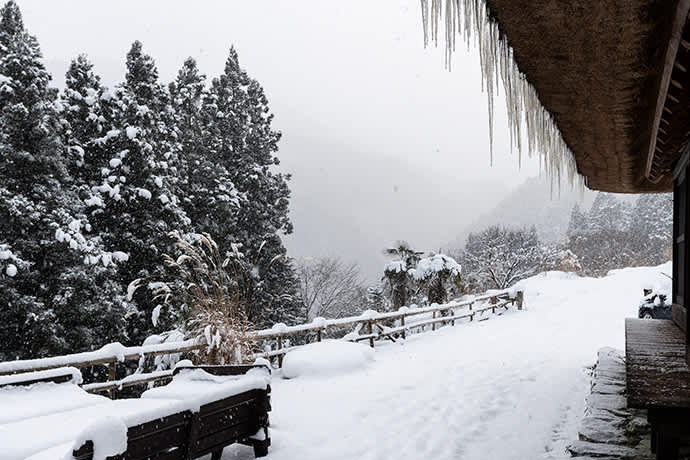
Each season in Iya has a dramatically different atmosphere, and each is beautiful in its own way.
Take time to sit on the traditional wood veranda (engawa) outside the living room and make Iya bancha tea while looking out at the snow-covered landscape. Iya bancha is tea from the Iya Valley that has been processed entirely by hand, from picking to drying. It’s sometimes called “phantom tea,” because it’s not often found outside of the region.

Complimentary Iya bancha tea and mineral water are always available.
The aroma of the tea leaves and the mix of bitter and sweet flavors is simple, but satisfying. While sitting on the veranda, it’s easy to let thoughts wander, and enjoy the slow passage of time.
After checking out, take some time to explore the area. On the way back to Oboke Station, visitors can see the famous Iya Vine Bridge that traverses a deep ravine. The vine bridge is a primitive suspension bridge, made by braiding wild vines, which is carefully maintained and replaced every three years. At one time, there were 14 vine bridges in Iya, but now there are just three. It’s said the Heike clan that retreated here after losing a battle in the twelfth century, constructed these bridges of braided vines so they could cut them at any time, to escape their pursuers.
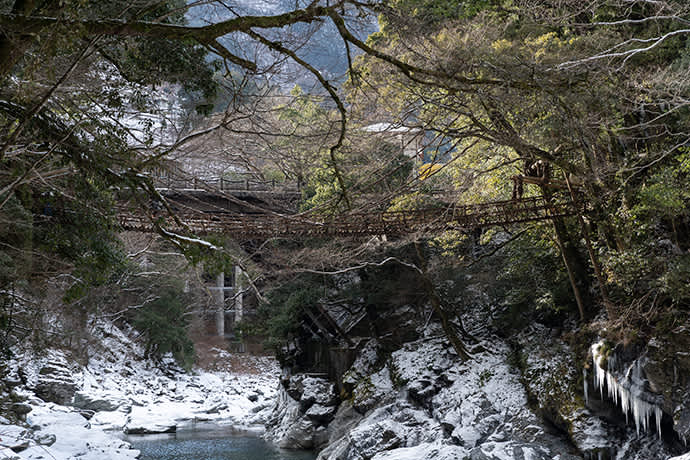
The bridge is lit up from 7:30 a.m. to 9:30 p.m. each night.
The bridge is suspended 14 meters (46 ft) above the Iya River. The wooden treads of the bridge have wide gaps between them. Some visitors find themselves almost too frightened to move. Today, the bridge is secured with wire and metal fittings, and rebuilt once every three years so it is very safe, but every time people walk cross the bridge it sways, eliciting shrieks and squeals.

The 45-meter long (147 ft) vine bridge can be dangerous if wearing unsuitable shoes.
Currently, there are two types of vine bridges in Iya. Alex Kerr recommends the Oku-Iya Double Vine Bridge, about 30 kilometers (18 mi.) east of the Iya Vine Bridge. Here, there are two vine bridges in this remote location that are inaccessible by car, so it’s an out-of-the-way spot with few tourists.
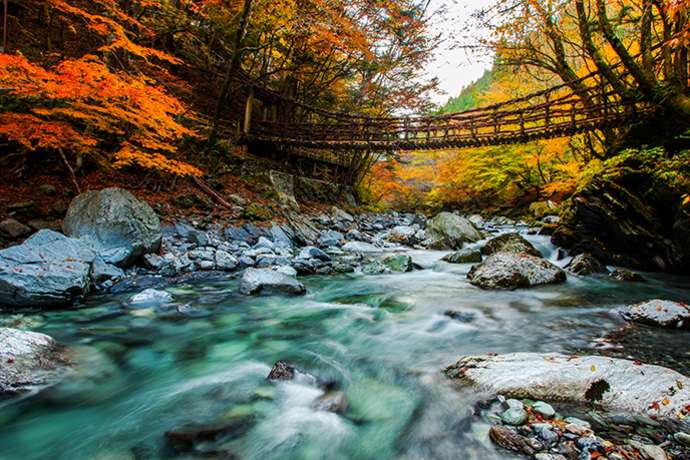
There is also a campsite near the Oku-Iya Double Vine Bridge.
Another well-known spot in the area, around 30 minutes by car from Oboke Station, is the Peeing Boy of Iya Valley. This classical bronze statue of a boy, standing at the precipice of a cliff, is an unexpected and very popular site to take a photo.
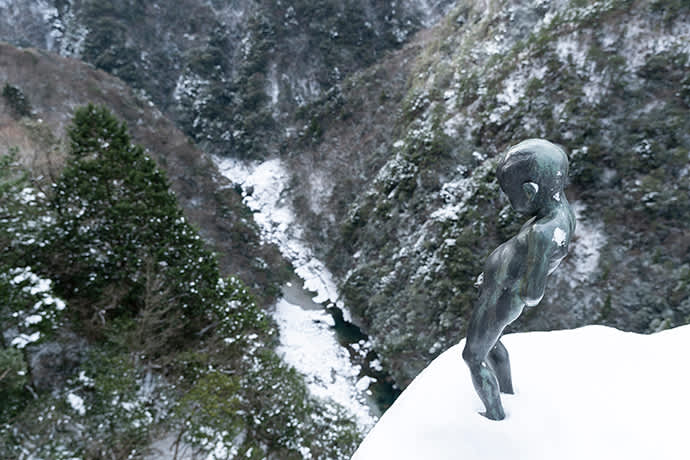
The Peeing Boy of Iya Valley stands looking over the deep gorge below.
More opportunities to experience the natural beauty of this secluded region
The Nishi-Awa region, surrounded by rugged mountains, has natural beauty to explore in every season. There are plenty of tours and activities to help visitors enjoy this mysterious, hidden paradise with all their senses. Make the most of a trip to Iya with one of these experiences.
A thousand years, a hidden hamlet: A tour of secluded Okuiya
This tour by charter taxi takes visitors to little-known sites in communities where people have lived alongside nature on the steep mountain slopes, for over a thousand years. Starting with the Oku-Iya Double Vine Bridge introduced earlier, tourists can visit many spots that would be hard to reach on their own. See the Ochiai community and its district of historic buildings, and visit the mysterious Nagoro community, where residents are outnumbered by dolls (kakashi) created from bamboo and straw to keep out harmful animals. The taxi picks up and drops off at the station and hotels, and an experienced driver knowledgeable about the local sights will introduce the attractions. There are also taxis capable of handling multiple languages, and tours that provide an English-speaking guide.

Visitors can experience the mountain village landscape of Iya, designated a Globally Important Agricultural Heritage System.
Ahashi Unkai (sea of clouds) Outlook Route
Unkai refers to the natural phenomenon of mist settling in valleys, resembling a sea when observed from above. Visitors can see this phenomenon from an observation deck with panoramic views of Oboke Gorge and Iya Valley. Enjoy the dramatic view of the white mist rising up from the Yoshino River. The frequency of phenomenon is highest March–April and October–December, on clear days when there is a significant difference in temperature from the day before. The best viewing time is from sunrise to around 7:30 a.m. A taxi will pick up and drop off guests from each accommodation.
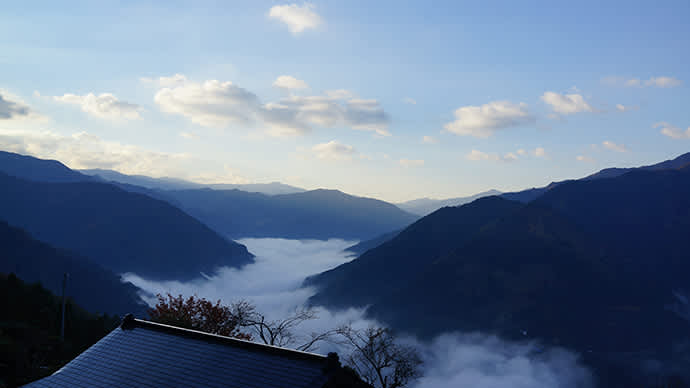
The outlook over the Oboke and Iya Valleys is a popular place to take photos. Photo credit: City of Miyoshi
Oboke Gorge Sightseeing Boat
This sightseeing boat cruises down through Oboke gorge, which is thought to have been carved out by the swift current of the Yoshino River approximately 200 million years ago. The contrast between the wild rock face and clear blue stream creates picturesque scenery. The new greenery from spring to summer and the fall foliage in autumn are particularly beautiful. The boat departs from and arrives back at Restaurant Obokekyo Mannaka.

The short ride is approximately 30 minutes round trip. COVID-19 countermeasures are thoroughly implemented, including disinfecting and spaces between seats. Photo credit: Obokekyo Mannaka
Information
Chiiori |
Iya Vine Bridge |
Oku-Iya Double Vine Bridge |
|
WEB:https://miyoshi-tourism.jp/en/spot/okuiyanijukazurabashi/ |
Iya Valley and the Peeing Boy of Iya Valley |
A thousand years, a hidden hamlet: A tour of secluded Okuiya |
Ahashi/Unkai Observation Deck Course |
Oboke Valley Sightseeing Boat |
|
WEB:https://www.mannaka.co.jp/restaurant/excursionship/excursionship.html |
Related Links
Discover Tokushima |
Nishi-Awa Tourism Association Sora-no-sato |
Setouchi Finder |




















































